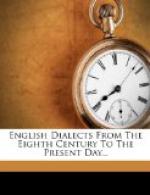Manuscripts in the Southern dialect are fairly abundant, and contain poems, homilies, land-charters, laws, wills, translations of Latin treatises, glossaries, etc.; so that there is considerable variety. One of the most precious documents is the history known as the Anglo-Saxon Chronicle, which was continued even after the Conquest till the year 1154, when the death and burial of King Stephen were duly recorded.
But specimens of the oldest forms of the Northern and Midland dialects are, on the other hand, very much fewer in number than students of our language desire, and are consequently deserving of special mention. They are duly enumerated in the chapters below, which discuss these dialects separately.
Having thus sketched out the broad divisions into which our dialects may be distributed, I shall proceed to enter upon a particular discussion of each group, beginning with the Northern or Northumbrian.
CHAPTER III
THE DIALECTS OF NORTHUMBRIA; TILL A.D. 1000
In Professor Earle’s excellent manual on Anglo-Saxon Literature, chapter V is entirely occupied with “the Anglian Period,” and begins thus:—“While Canterbury was so important a seminary of learning, there was, in the Anglian region of Northumbria, a development of religious and intellectual life which makes it natural to regard the whole brilliant period from the later seventh to the early ninth century as the Anglian Period.... Anglia became for a century the light-spot of European history; and we here recognise the first great stage in the revival of learning, and the first movement towards the establishment of public order in things temporal and spiritual.”
Unfortunately for the student of English, though perhaps fortunately for the historian, the most important book belonging to this period was written in Latin. This was the Historia Ecclesiastica Gentis Anglorum, or the Church History of the Anglian People. The writer was Beda, better known as “the Venerable Bede,” who was born near Wearmouth (Durham) in 672, and lived for the greater part of his life at Jarrow, where he died in 735. He wrote several other works, also in Latin, most of which Professor Earle enumerates. It is said of Beda himself that he was “learned in our native songs,” and it is probable that he wrote many things in his native Northumbrian or Durham dialect; but they have all perished, with the exception of one precious fragment of five lines, printed by Dr Sweet (at p. 149) from the St Gall MS. No. 254, of the ninth century. It is usually called Beda’s Death-song, and is here given:
Fore there neidfaerae naenig uuiurthit thonc-snotturra than him thar[f] sie, to ymbhycggannae, aer his hin-iong[a]e, huaet his gastae, godaes aeththa yflaes, aefter deoth-daege doemid uueorth[a]e.
Literally translated, this runs as follows:




